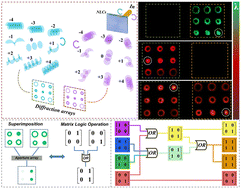Wavelength-adaptive optical angular momentum recognizer via programmable soft materials†
Abstract
The orthogonal spin angular momentum (SAM) and orbital angular momentum (OAM) of light, which together expand into multiple dimensions in photonics, need to be identified. However, their recognition with dynamic modulability and broadband wavelength adaptability remains challenging. Herein, we achieve the simultaneous one-step identification of both SAM and OAM, based on a liquid crystal (LC) recognizer with a programmed geometric phase structure. By retrieving the propagation direction and exclusive non-vortex Gaussian beam of the resultant diffraction array, the SAM and OAM of impinged light can be precisely recognized, and the superimposed states involving multiple SAMs and OAMs can also be identified through demultiplexing. Thanks to the unique stimuli-responsiveness of LCs, the recognizer can be promptly switched on/off as required, and dynamically adapt to any wavelength in an extremely broad range covering the visible and NIR bands. Inspired by the concept of an optical logic gate matrix, an information processing system is established by encoding the diffraction matrices with some specific information. We anticipate that this work will be promising to give fascinating dynamic responsiveness and spectral adaptability to integrated optical communications and motivate research into the new scenario of information processing loading on angular momenta.

- This article is part of the themed collection: Journal of Materials Chemistry C HOT Papers


 Please wait while we load your content...
Please wait while we load your content...